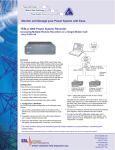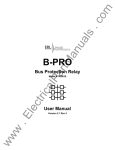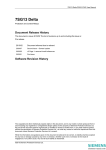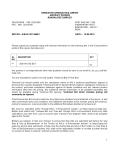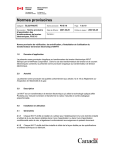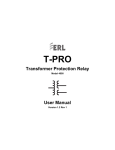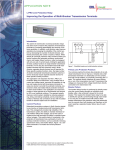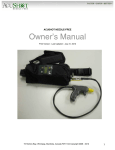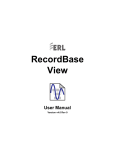Download Bus Differential Function Settings
Transcript
People with Passion B-PRO Bus Protection Relay Best in Class Technology Bus Differential Function Settings Power System Focus Monitor and Manage your Power System with Ease. B-PRO Bus Protection Relay Bus Differential Function Settings Introduction The B-PRO Bus Protection Relay provides low-impedance differential protection for transmission and distribution buses, for up to 6 three-phase inputs. The B-PRO is a per-unit based relay, meaning all secondary currents entering the relay are converted to per-unit values for protection calculations. Choosing the correct per-unit base for the current permits the development of standard protection settings that work for most bus protection applications. The resulting settings method only requires 2 calculations to implement. The settings described in this technical note will provide a good balance between dependability and security of the protection system. This method also assumes the CTs have burdens within their ratings, and that the measured secondary current by the CTs is between 0.2 A and 15 A secondary. Bus Differential (87B) Protection Function Characteristic The operating characteristic of the 87B function is shown in Figure 1. IOmin is the minimum operating current for fault detection. IRs is the setting for the breakpoint between the region of slope S1 and the region of slope S2. IRs is normally used as the upper limit of the “load range”, or the protection zone used to detect bus faults during normal load conditions. The S2 region is therefore used for protection during through-fault events, where CT measurement errors can be quite large. The High Current Setting is an un-restrained differential element. Settings are described more completely in the B-PRO instruction manual.In addition to this operating characteristic, the B-PRO includes a CT Saturation Detection algorithm that correctly identifies CT saturation due to external faults, and blocks the differential element from tripping. IO High Curr ent Setting Op er ate Restrain S2 IO min S1 IR IR s Figure 1: 87B operating characteristic In addition to this operating characteristic, the B-PRO includes a CT Saturation Detection algorithm that correctly identifies CT saturation due to external faults, and blocks the differential element from tripping. While performing setting calculations for the B-PRO, the IO operate current is calculated by the equation: IO = I 1+ I 2+ I 3+ I 4+ I 5+ I 6 A per unit The restraint current IR calculation is: I1 + I 2 + I 3 + I 4 + I 5 + I 6 IR = 2 A per unit Our multi function relays and recorders provide smart solutions to your protection, monitoring and control needs. www.erlphase.com ERLPhase (formerly a division of NxtPhase), is a subsidiary of Easun Reyrolle Ltd with over 60 years of power management expertise. smart solutions that empower you smart solutions that empower you [email protected] www.erlphase.com 204-477-0591 [email protected] 74 Scurfield Blvd 204-477-0591 Winnipeg, MB 74 Scurfield Blvd Canada R3Y 1G4 Winnipeg, MB Canada R3Y 1G4 B-PRO Bus Protection Relay Bus Differential Function Settings Settings Philosophy The recommended settings method described in this technical note is simple: choose the MVA Base setting of the relay such that the maximum bus transfer load current is equal to the IRs setting in per-unit current. All other settings are related to the per-unit base current. The preferred setting for IRs is 2 per-unit, but there are some applications where a higher value is required. This method ensures that IRs is the upper limit setting for the load range, provides dependability for normal operating conditions, and provides adequate security for through-fault events. The basic settings philosophy is to make sure operating and restraint current values (during normal operating conditions) fall in the “load range.” This means the S1 range accommodates the actual operating current, accounting for the maximum CT measurement error under any load condition. External fault conditions will be in the S2 or High Current range of the characteristic. Figure 2 describes recommended settings for most bus differential applications. Figure 2: 87B settings Settings Method The clearest way to understand the proposed bus differential settings method is through a specific example. Figure 3 illustrates normal load conditions. 1600 A 2000 A 200 0 A 2000: 5 200 0: 5 52 1500 A 200 0: 5 52 900 A 200 0: 5 52 1200: 5 52 52 138 kV 87B Figure 3: Bus transfer load smart solutions that empower you www.erlphase.com [email protected] 204-477-0591 74 Scurfield Blvd Winnipeg, MB Canada R3Y 1G4 B-PRO Bus Protection Relay Bus Differential Function Settings Settings are developed using simple steps: 1. Enter Winding/CT connection information 2. Determine the maximum bus transfer current 3. Choose a value for IRs 4. Calculate the Bus Base MVA 5. Determine the CT Saturation Block Timer 6. Enter settings in the B-PRO 1. Enter Winding/CT Connection Information Enter Winding and CT connection information to match the specific bus protection application, as in the example of Figure 4. Figure 4: Winding/CT Connections settings 2. Determine the Maximum Bus Transfer Current The maximum bus transfer current is going to be based on the CT primary ratings. For the example of Figure 3, there are many load flow configurations possible, but it is not possible to exceed an inflow of 4000 Apri without exceeding at least one CT rating. Therefore, 4000 Apri is the maximum bus transfer condition for this bus. It is possible, of course, for the maximum bus transfer current to be smaller than the rating limits of the CTs due to other system constraints. 3. Choose a Value for IRs The IRs setting determines the break point between the slope S1 and slope S2. The IRs setting is also the upper limit of the “load range” of the B-PRO. For this recommended settings method, the maximum bus transfer current is equal to IRs in per-unit current. The preferred setting for IRs is 2 per-unit, which will work for most applications, but IRs can be any whole number 2 or greater. This method ensures the IR restraint current of the B-PRO for maximum bus transfer current is always within the upper limit of the “load range”. 4. Calculate the Bus Base MVA The B-PRO does not have an explicit setting for the current base, but calculates the current base from the Bus Voltage and Bus Base MVA settings. Therefore, choosing the base current requires calculating the Bus Base MVA. Bus Base MVA = 3 × Bus Voltage × Base Current Maximum bus transfer current = IRs Base Current = Maximumbus transfer current ( A pri ) IRs ( A per unit ) smart solutions that empower you www.erlphase.com [email protected] 204-477-0591 74 Scurfield Blvd Winnipeg, MB Canada R3Y 1G4 B-PRO Bus Protection Relay Bus Differential Function Settings For the configuration of Figure 3, the maximum bus transfer current = 4000A, and IRs = 2 per-unit. Base Current = 4000 A pri 2 A per unit = 2000 A Bus Base MVA = 3 ×138 kV × 2000 A = 478 MVA Enter this amount as a relay setting in System Parameters, as illustrated in Figure 5. Figure 5: System Parameters settings The maximum relay setting for the Bus Base MVA in the B-PRO is 1000 MVA. (This setting range will be modified to 10,000 MVA in a future product update). If the calculated Bus Base MVA exceeds this value, choose the next higher whole number value for IRs (3 per-unit in this example), and re-calculate the Bus Base MVA. 5. Determine the CT Saturation Block Timer The settings method used in this Technical Note assumes the CT Saturation Detector is enabled. When an external fault occurs on a feeder, it can look like an internal fault if the feeder CTs saturate sufficiently. The “saturation detection algorithm” detects this condition and blocks tripping. It does not block tripping for CT saturation during an internal fault. Once the CT Saturation Detector has identified a CT saturation condition, the 87B function is blocked from tripping until the CT Saturation Max Block timer expires. This setting should be greater than the slowest fault clearing time for any of the feeders connected to the bus. A typical clearing time is 5 cycles, or 2 cycles to recognize the fault and 3 cycles for the circuit breaker to open. The minimum setting of 0.10 seconds provides some safety margin. 6. Enter Settings in the B-PRO The un-restrained differential High Current Setting should be set at 5 x IRs. For this example, 5 x 2 = 10 per-unit. IOmin is set at 0.25 per-unit, other than for applications with widely diverse CT ratios. S1 is recommended to be at 25%, and S2 at 50%, as shown in Figure 2. smart solutions that empower you www.erlphase.com [email protected] 204-477-0591 74 Scurfield Blvd Winnipeg, MB Canada R3Y 1G4 B-PRO Bus Protection Relay Bus Differential Function Settings Widely Diverse CT Ratios “Widely diverse CT ratios” differ by more than 5-to-1 (for example, 1200:5 and 8000:5). With widely diverse CT ratios, there is a possibility of false tripping under light load conditions. Consider a case such as Figure 6: 320 A 320 A = 0. 27 p u 1.3 3 A se c 120 0:5 0 A se c 1200: 5 52 0. 2 A se c 8000: 5 52 52 138 kV 87B Figure 6: Widely diverse CT ratios Assume that the base current is chosen in the same way described by this Technical Note. Thus the maximum bus transfer current through this bus is 2400 A, and the base current for the bus differential protection is 2400 A/2 = 1200 A. When the secondary current of a nominally 5A CT is as small as 0.2 A, there is a possibility that the current may be interpreted as close to zero amps, due to CT error and A-to-D conversion error. Assuming the worst case, 0.2 amps is interpreted as zero amps by the relay. Then, for this light load condition the operating current, IO, is perceived as 320 – 0 = 320 primary amps. On a 1200 A base this is 0.27 per-unit, which is above the recommended setting for IOmin, namely 0.25 per-unit. For this case, it is recommended to set IOmin to 0.4 per-unit in order to prevent possible false tripping of the bus. References [1] B-PRO Bus Protection Relay User Manual Version 1.1 Revision 2, NxtPhase Corporation, Vancouver, BC, Canada; 2000 smart solutions that empower you www.erlphase.com [email protected] 204-477-0591 74 Scurfield Blvd Winnipeg, MB Canada R3Y 1G4





